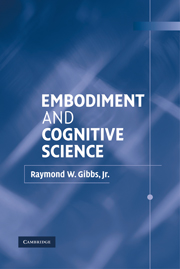6 - Language and Communication
Published online by Cambridge University Press: 05 June 2012
Summary
Communicating with others mostly requires that we move our bodies. When I speak to a friend, I move my lips, tongue, and vocal apparatus, along with various body parts not directly associated with speech, such as my eyes, hands, head, and torso. In some situations, I can effectively communicate some idea or belief simply by nodding my head or blinking my eyes. Even the absence of overt body movement can communicate, as when you stare blankly at me after I ask you a question. We interpret the lack of body movement as meaningful precisely because bodily motion normally communicates.
The traditional belief among many cognitive scientists is that meaning is an abstract entity divorced from bodily experience. Understanding language is assumed to require breaking down the physical information (e.g., speech sounds) into a language-independent medium that constitutes the “language of thought.” The meaning of any sentence presumably can be represented as a complex proposition consisting of a predicate with several arguments. Longer texts are represented in associative networks of propositions (predicate-argument schemas) or as abstract mental models (Fletcher, 1994; Fletcher, van den Broek, & Arthur, 1996; Kintsch, 1988). More recent approaches to the semantics of words and sentences include powerful quantitative tools, such as hyperspace analog to language (HAL) or latent semantic analysis (LSA), both of which reduce the problem of meaning to a simple matter of computing word co-occurrence (Burgess, 2000; Burgess & Lund, 2000; Kintsch, 1998).
Information
- Type
- Chapter
- Information
- Embodiment and Cognitive Science , pp. 158 - 207Publisher: Cambridge University PressPrint publication year: 2005
